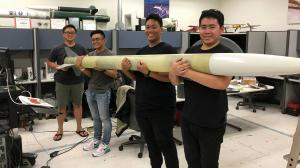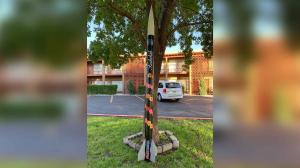UH Mānoa students in New Mexico prep for rocket launch competition
VIDEO NEWS RELEASE
University of Hawaiʻi at Mānoa
UH Mānoa engineering students Adam James Macalalag, Eric Takahashi, Efren Enriquez, Matthew Nakamura
LINK TO VIDEO AND SOUND (details below): https://bit.ly/31FXbt4
WHO: Six of the nine University of Hawaiʻi at Mānoa engineering students who comprise the Project Hōkūlele team, working on a UH Aerospace Technologies Vertically Integrated Project (VIP).
UH is part of the Vertically Integrated Projects (VIP) Consortium, which consists of more than 30 institutions worldwide. VIP programs seek to foster long-term, in-depth, project-based learning to engage students and better prepare them for future careers.
WHAT: The students are preparing to launch the rocket and payloads they built for the Spaceport America Cup competition hosted by the Experimental Sounding Rocket Association (ESRA).
-
Their 11.5-foot-tall rocket is named Kahekili.
-
There are two experimental payloads.
-
One payload is a 3U CubeSat shell with an onboard computer system to determine whether the onboard computer system will be able to withstand launch forces. (According to NASA, CubeSats are a class of research spacecraft called nanosatellites. CubeSats are built to standard dimensions or “U” of 10 cm x 10 cm x 10 cm and typically weigh less than 1.33 kg or 3 lbs per U.)
-
The second payload is an array of transducers (a device that converts energy from one form to another) that will measure the vibrations of the rocket body during flight. The data will be used to better understand the forces acting on a rocket during flight, which can be applied to future rocket construction.
WHEN: Launch is scheduled for Wednesday, June 19 between 9 a.m. - 2 p.m. HST (UH News plans to send out VNR of launch.)
WHERE: Las Cruces, New Mexico
WHY: By participating in the Spaceport America Cup, the students will gain valuable insight and hands-on experience in the field of aerospace technology.
HOW: $10,000 in funding from the Undergraduate Research Opportunities Program covered the cost of the rocket and some travel expenses, along with $1,000 from the College of Engineering, which covered additional travel expenses.
OTHER FACTS:
Spaceport America Cup offers collegiate rocketeers a unique opportunity to:
- Present the results of their research and development to peers and prospective employers.
- Put their designs to the test by attempting launch under real-world conditions.
- Network with peers from universities across the country and industry sponsors.
The competition gives students the opportunity to launch a rocket that they would otherwise have been unable to due to restrictions, such as limitations on motor size, in their home states.
VIDEO:
BROLL: (57 seconds)
0:00-0:37, 8 clips: preparation for the Spaceport America Cup at New Mexico
0:37-0:57, 5 photos: students working on the rocket at the Windward CC aerospace exploration lab


